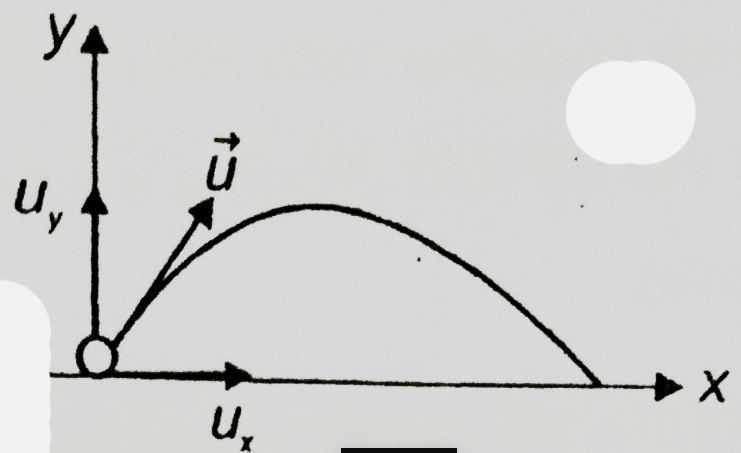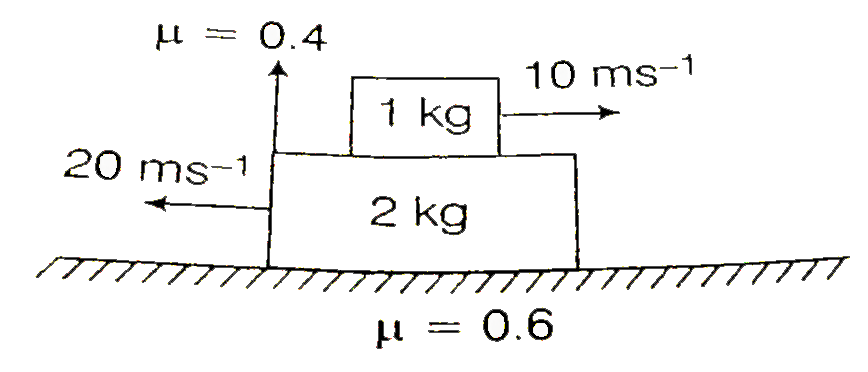Match the following columns.
Column IColumn II(A) Force of friction(p) Oppose motion(B) Normal reaction on a block kept on horizontal ground(q) Oppose relative motion(r) Is always mg(s) May be equal to mg(t) None
The correct Answer is:A → t,B→s
Force of friction opposes relative motion between two bodies in contact. It does not simply opposes the relative motion. Further, N=mg, only when no inclined force is acting on the block as shown in figure.

Topper's Solved these Questions
- LAWS OF MOTIONBOOK - DC PANDEYCHAPTER - LAWS OF MOTIONEXERCISE - Medical entrances gallery
39 Videos
- LAWS OF MOTIONBOOK - DC PANDEYCHAPTER - LAWS OF MOTIONEXERCISE - Assertion and reason
28 Videos
- KINEMATICS 1BOOK - DC PANDEYCHAPTER - KINEMATICS 1EXERCISE - INTEGER_TYPE
15 Videos
- LAWS OF THERMODYNAMICSBOOK - DC PANDEYCHAPTER - LAWS OF THERMODYNAMICSEXERCISE - Level 2 Subjective
18 Videos
Similar Questions
A particle is projected from level ground near the surface of earth with intitial velocity →u=uxˆi+uyˆj ,as shown in the figure. If a(x)anday are the components of acceleration in horizontal and vertically downward directions then

Match the following columns.
(Column I,Column II), ( (A) Projectile motion,(p) Uniform motion)((B) A block sent sliding on a smooth horizontal surface,(q) Unifromly accelerated motion),((C) Unifrom circular motion , (r) motion with non- uniform acceleration),( (D) Swing of pendulum ,(s) Non-uniform motion):}
View SolutionIn the diagram shown in figure. Match the following columns.

Colmun IColumn II(A) Absolute acceleration of 1 kg block(p)11ms−2(B) Absolute acceleration of 2 kg block(q)6ms−2(C) Relative acceleration between the two(r)17ms−2(s)None
View SolutionIn the diagram shown in figure. Match the following columns.

Colmun IColumn II(A) Absolute acceleration of 1 kg block(p)11ms−2(B) Absolute acceleration of 2 kg block(q)6ms−2(C) Relative acceleration between the two(r)17ms−2(s)None
View SolutionMatch the following :
Column IColumn II(a) Sandmeyer reaction(p) Chlorobenzene(b) Gattermann reaction(q) Bromobenzene(c) Rasching method(r) Benzyl chloride(d) Chlorination of toluene(s) Iodobenzene
View SolutionIn the diagram shown in figure, match the following columns (take g=10ms−2)

Column IColumn II(A) Normal reaction(p) 12 SI unit(B) Force of friction(q) 20 SI unit(C) Acceleration of block(r) zero(s) 2 SI unit
View SolutionIn the diagram shown in figure, match the following columns (take g=10ms−2)

Column IColumn II(A) Normal reaction(p) 12 SI unit(B) Force of friction(q) 20 SI unit(C) Acceleration of block(r) zero(s) 2 SI unit
View SolutionColumn - I and Column - II contains four emtries each. Entries of Column -I are to be matched with some entries of Column - II . One or more than one entries of Column -I may have the matching with the same entries of Column - II.
column-Icolumn-II(A) peptization (P) preparation of sols (B) Ultra centrifugation (Q) Purification of sols (C) Electrodialysis(R) perparation of metal sols (D) Breding's arc method (S) movement of ions acress the membrane in prsence of electric field
View SolutionColumn - I and Column - II contains four emtries each. Entries of Column -I are to be matched with some entries of Column - II . One or more than one entries of Column -I may have the matching with the same entries of Column - II.
column-Icolumn-II(A) peptization (P) preparation of sols (B) Ultra centrifugation (Q) Purification of sols (C) Electrodialysis(R) perparation of metal sols (D) Breding's arc method (S) movement of ions acress the membrane in prsence of electric field
View SolutionMatch the Column-I with Column-II :
Column-IColumn-II(a)Rate of reaction(p)May be fractional(b)Rate of constant(q)Whole number(c)Order of reaction(r)Indepdent of temperature(d)Molecularity of raction(s)Increase with temperature
View SolutionMatch column - I with column -II
Column -IColumn -II(a)Gravitational force(p)Central(b)Viscous force(q) Non-conservative(c)Electric force(r) Conservative(d)Friction(s) Mechanical energy is conserved
View Solution
